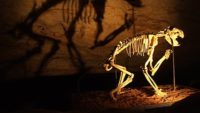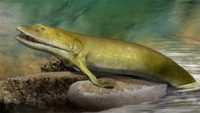Evolutionists are celebrating the discovery of what they claim is a small dinosaur skull trapped in Burmese amber.1 Oculudentavis khaungraae is declared to be a tiny Mesozoic dinosaur that is 99 million years old. Yet, the physical traits point to it being 100% bird. Lars Schmitz, associate professor of biology, stated, “Its unique anatomical features point to one of the smallest and most ancient birds eve… More… …read more Source: icr.org
Last month, the ICR Discovery Center hosted “Origins: Re-examining the Evidence,” a special event featuring three of ICR’s scientists—experts in geology, fossils and human origins, and genetics. The purpose of the event was to explore claims secular anthropologists have made about supposed ancestors of modern humans. ICR’s Dr. Jeff Tomkins, Dr. Tim Clarey, and Dr. Brian Thomas each presented compelling arguments from… More… …read more Source: icr.org
A recent study has ruled out a possible candidate for dark matter, the mysterious invisible “stuff” said to comprise 85% of the matter in our universe.1,2 The Big Bang model needs dark matter for a number of reasons. So, this is bad news for the Big Bang model. Most secular cosmologists believe in dark matter. Some biblical creationists also think dark matter exists,3 but others (including me) are … More… …read more Source: icr.org
Is it ok for humans to modify organisms? What about human-animal hybrids? We discuss the biblical and ethical guidelines for Christians in today’s world of rapidly developing biotechnology. …read more Source: creation.com
To the Ark, and Back Again? Using the Marsupial Fossil Record to Investigate the Post-Flood Boundary
By Chad Arment There is no debate as contentious as the post-Flood boundary issue within creation science. …read more Source: AIG Daily
Neanderthals are classified by evolutionists as archaic humans given that both their DNA and bones are essentially human. Yet, new stories constantly hit the headlines with the supposedly shocking news that anatomically modern humans and Neanderthals were found to have interbred once again. Recently, another such story appeared in the journal Genetics.1 Why is this type of news so exciting, yet also so confusing to ev… More… …read more Source: icr.org
High-speed creature communication has been making the news recently. There was underwater research on deep-sea squid,1 and now bird communication. In fact, the rapid signaling discovered in the honeyeater bird is all part of an intricate multi-part message that has scientists in awe at both its rapidity and complexity.2 The honeyeaters are a large and diverse family of small to medium sized birds mostly found … More… …read more Source: icr.org
Lingwulong shenqi, ‘amazing dragon of Lingwu’, is a Diplodocus-like dinosaur confounds evolutionists by being in the wrong place and time …read more Source: creation.com
A recent study in March 2020 suggested that sulfur dioxide (SO2) injected into Earth’s stratosphere could fight global warming, with a minimum of adverse effects.1,2 Here at ICR we generally think alarmism over “global warming” or “climate change” is unwarranted. We aren’t necessarily endorsing this proposal, but we can use it to shed light on what really caused the Ice Age…. More… …read more Source: icr.org
Now is the season—late March and April—for bluebonnets to blossom in Texas!1 Establishing these beautiful flowers is difficult, as many have learned. But that difficulty is itself telltale evidence of God’s bioengineering care, because those flowers need much more than luck to succeed! Consider the lilies of the field, how they grow; they neither toil nor spin; and yet… More… …read more Source: icr.org
Where did disease-causing viruses come from? …read more Source: creation.com
Stumps big bang boffins …read more Source: <a href=https://creation.com/a/14176 target=_blank title="Synchronized dance of dwarf galaxies” >creation.com
By Ken Ham With our fingers we can type on a keyboard, play notes on a piano, and sketch a detailed landscape. Whom do we have to thank for these nimble appendages? Well, according to a recent news item, we can express our thanksgiving to . . . an extinct fish! “Thank This Fish for Your Fingers” Researchers recently reported the discovery and analysis of a nearly complete (yet poorly preserved) specimen of a supposedly 380-million-year-old fish, Elpistostege watsoni. This five-foot-long fish, found in modern-day Quebec, Canada, is being heralded as a “transitional form” between fish and tetrapods (four-legged animals). [More]
At church meetings, Ross still makes blatantly false claims, including about church fathers, human fossils, Neandertals, and the flood. …read more Source: creation.com
On March 18, 2020, a 5.7 magnitude earthquake shook the Salt Lake City area. Specifically, it hit underneath the town of Magna, Utah. Since that time, over 650 aftershocks have continued to rumble through the rocks beneath the town. Three aftershocks reached about 4 in magnitude, 20 about 3 in magnitude, and 122 around 2 in magnitude.1 The earthquake actually originated about 8 miles below the town of Magna, Utah. It sho… More… …read more Source: icr.org
Mutations can add information, so why is that not evolution? Read More
By Ken Ham What do the star Betelgeuse, “mini-moons,” dark energy, and the big bang all have in common? They’re all topics of discussion of astronomical importance on the latest issue of Answers News, our weekly live news program. Normally, three co-hosts discuss the latest in science and culture news from a biblical perspective. But this week’s episode was a bit different. One of our regular hosts, Bodie Hodge, was joined by AiG astronomer Dr. Danny Faulkner to discuss what’s going on in astronomical research and point you back to biblical truth as it relates to the heavens, stars, moons, [More]
By Dr. Danny R. Faulkner Discover how a new “mini-moon” orbits the earth, how it compares with the primary moon, where it’s going, and what is the relevance for Christians. …read more Source: AIG Daily
Where did disease-causing bacteria come from? …read more Source: creation.com
In the deep, dark, cold waters of the Pacific Ocean—about 1,500 feet below the surface— hundreds of Humboldt squid the size of small humans (~ 5 feet long) were recently observed feeding on a school of lantern fish only about 3 to 4 inches long. The scientists used a high-tech remotely operated vehicle (ROV) with highly sophisticated photographic equipment to document the squid’s behavior. What they discovered was shockingly sop… More… …read more Source: icr.org
Evolutionary scientists are still trying to understand what happens when tectonic plate subduction stops. They are also baffled by rapid crustal uplift near subduction zones. Yet, we see clear evidence of the slowing of tectonic plates and the rapid rise of mountains globally. Secular science hasn’t realized that these two processes are simply an expected consequence of the end of the Genesis Flood around 4,500 years ago. More… …read more Source: icr.org
“Said to have ‘alien biology’, and are ‘too brainy’ for their age!”. …read more Source: creation.com
By Dr. Joe Francis Before modern cameras and technology, the inky blackness of the deep barred its mysteries from human eyes. But now these wonders are coming to light. …read more Source: AIG Daily
The arrangement of branches and leaves maximizes gas absorption. Supercapacitor modeled on this pattern, albeit a millionth the size, maximizes charge storage capacity. …read more Source: creation.com
Darwin’s theory of evolution makes several predictions about adaptation. But recent genetic findings raise questions about the accuracy of evolutionary theory, since the findings point toward different types of engineered adaptability. The latest challenges to Darwin’s theory, published in March 2020, come from the fascinating insects known as turtle ants. More… …read more Source: icr.org
It’s mole season. Moles get active in springtime, especially during March and April. Moles are mostly hidden out of plain sight, but they are actually important members of God’s creation. Many people dislike moles, due to how the creatures wrinkle lawn surfaces, but the ecological benefits usually outweigh such minor yard-care nuisances. Moles are known for digging. But how do they dig? More… …read more Source: icr.org













































